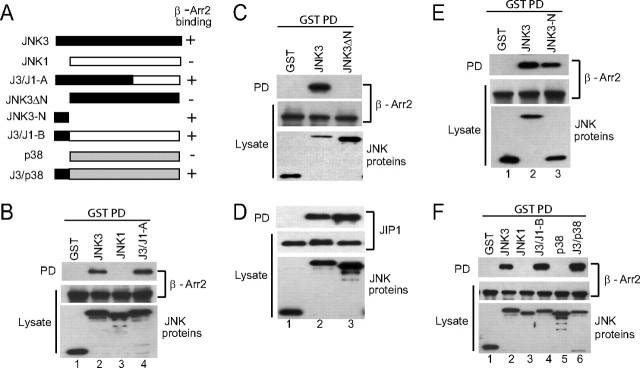FIGURE 1.
The extended N terminus of JNK3 binds to β-arrestin-2. A, schematic of the JNK and p38 constructs used in the experiments and a summary of their binding to β-arrestin-2 (- represents no binding; + represents binding). B, constructs expressing GST, GST-JNK3, GST-JNK1, or the chimera GST-J3/J1-A were introduced into COS-7 cells together with an expression vector for FLAG-β-arrestin-2. GST-containing complexes were isolated from cell lysates with glutathione-Sepharose beads and FLAG-β-arrestin-2 (β-Arr2) present in the pull-down (PD) was examined by immunoblot analysis using the M2 antibody. The expression of the GST-JNK constructs and FLAG-β-arrestin-2 in the lysates was examined by immunoblotting. C and D, constructs expressing GST, GST-JNK3, or GST-JNK3ΔN were introduced into COS-7 cells together with an expression vector for FLAG-β-arrestin-2 (C) or FLAG-JIP1 (D). GST-containing complexes were isolated from cell lysates with glutathione-Sepharose beads and the β-arrestin-2 or JIP1 present in the pull-down (PD) was examined by immunoblot using M2 antibody. The expression of the JNK mutants, β-arrestin-2 and JIP1 was examined by immunoblotting the lysates with anti-GST and M2 antibodies, respectively. E and F, constructs expressing GST or the indicated GST-JNK3 mutants were introduced into COS-7 cells together with an expression vector for FLAG-β-arrestin-2. GST-containing complexes were isolated from cell lysates with glutathione-Sepharose beads and the β-arrestin-2 present in the pull-downs (PD) was examined by immunoblot using M2 antibody. The expression of the JNK mutants and β-arrestin-2 was examined by immunoblotting the lysates with anti-GST and M2 antibodies, respectively. Experiments were performed either two or three times and representative immunoblots are shown.

